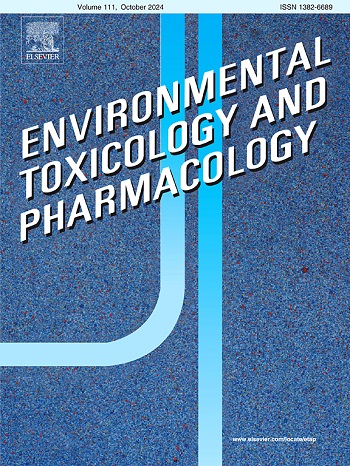双酚A替代品(BPS和BPAF)对斑马鱼体外精子发生的影响:减数分裂损伤和与精子发生过程和表观遗传调控相关基因的转录失调
IF 4.2
3区 环境科学与生态学
Q2 ENVIRONMENTAL SCIENCES
引用次数: 0
摘要
环境污染物BPS和BPAF是BPA的新兴替代品,作为内分泌干扰物引起了人们的关注。本研究评估了它们对斑马鱼精子发生的影响,使用体外睾丸外植体暴露于0.5、5或50 µg/L每种化合物7天。这两种化学物质都通过减少减数分裂(Spcp)和减数分裂后(Spt)的囊肿形成来损害精子发生,其中BPS的作用更强。此外,他们还改变了与精子发生、类固醇发生和表观遗传调控相关的标记基因的表达。值得注意的是,cyp19a1a被两者上调,表明雌激素活性;BPS不影响雌激素受体的表达,提示其具有间接的抗雄激素机制,而BPAF调节esr1和esr2a,提示其具有直接的雌激素作用。我们的发现提供了证据,这两种化合物的剂量反应是非单调的。这些结果表明,BPS和BPAF可以破坏生殖和分子过程,挑战其作为双酚a替代品的安全性,并强调需要进一步研究和更严格的环境法规。本文章由计算机程序翻译,如有差异,请以英文原文为准。

Effects of bisphenol A alternatives (BPS and BPAF) on zebrafish (Danio rerio) spermatogenesis ex vivo: meiosis damage and transcriptional deregulation of genes related to spermatogenic processes and epigenetic regulation
Environmental contaminants BPS and BPAF, emerging substitutes for BPA, are raising concerns as endocrine disruptors. This study assessed their effects on zebrafish spermatogenesis using ex vivo testicular explants exposed to 0.5, 5, or 50 µg/L of each compound for 7 days. Both chemicals impaired spermatogenesis by reducing meiotic (Spcp) and post-meiotic (Spt) cyst formation, with BPS showing stronger effects. Additionally, they altered the expression of marker genes related to spermatogenesis, steroidogenesis, and epigenetic regulation. Notably, cyp19a1a was upregulated by both, indicating estrogenic activity; however, BPS did not affect estrogen receptor expression, suggesting an indirect antiandrogenic mechanism, while BPAF modulated esr1 and esr2a, indicating direct estrogenic effects. Our findings provide evidence that the dose-response for both compounds was non-monotonic. These results imply that BPS and BPAF can disrupt reproductive and molecular processes, challenging their safety as BPA substitutes and highlighting the need for further investigation and more stringent environmental regulations.
求助全文
通过发布文献求助,成功后即可免费获取论文全文。
去求助
来源期刊
CiteScore
7.00
自引率
4.70%
发文量
185
审稿时长
34 days
期刊介绍:
Environmental Toxicology and Pharmacology publishes the results of studies concerning toxic and pharmacological effects of (human and veterinary) drugs and of environmental contaminants in animals and man.
Areas of special interest are: molecular mechanisms of toxicity, biotransformation and toxicokinetics (including toxicokinetic modelling), molecular, biochemical and physiological mechanisms explaining differences in sensitivity between species and individuals, the characterisation of pathophysiological models and mechanisms involved in the development of effects and the identification of biological markers that can be used to study exposure and effects in man and animals.
In addition to full length papers, short communications, full-length reviews and mini-reviews, Environmental Toxicology and Pharmacology will publish in depth assessments of special problem areas. The latter publications may exceed the length of a full length paper three to fourfold. A basic requirement is that the assessments are made under the auspices of international groups of leading experts in the fields concerned. The information examined may either consist of data that were already published, or of new data that were obtained within the framework of collaborative research programmes. Provision is also made for the acceptance of minireviews on (classes of) compounds, toxicities or mechanisms, debating recent advances in rapidly developing fields that fall within the scope of the journal.

 求助内容:
求助内容: 应助结果提醒方式:
应助结果提醒方式:


